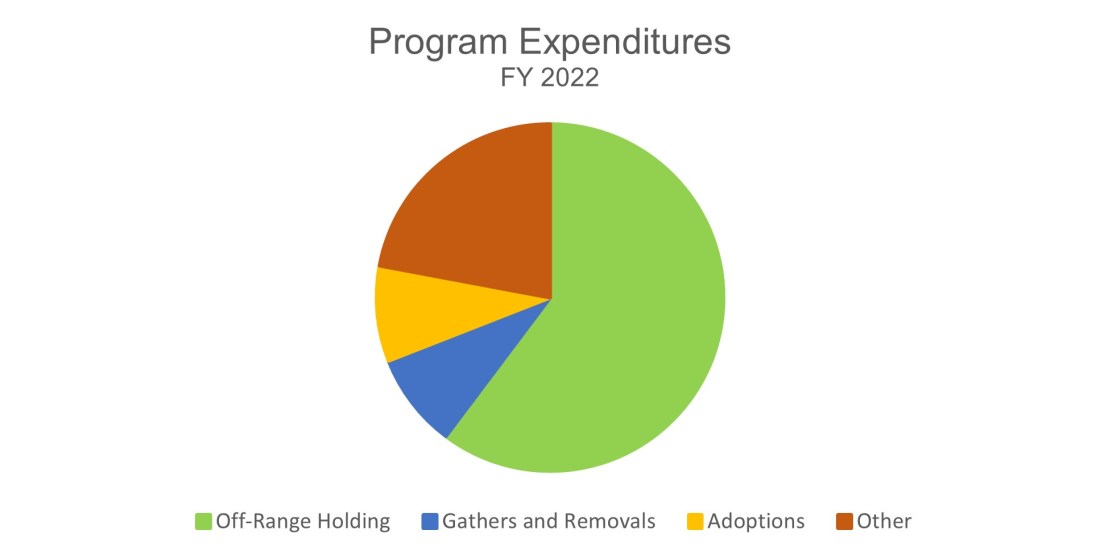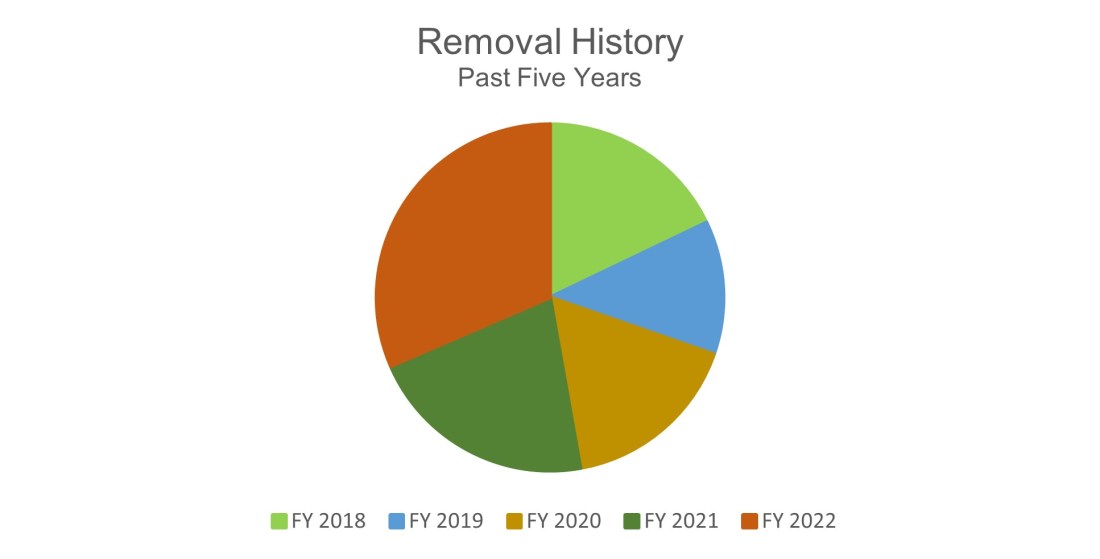Nineteen horses have been lost since the strangles outbreak was reported.
The facility has a capacity of 3,500 animals, with 2,617 horses and 29 burros held there as of November 21, according to the BLM Facility Report.
Nineteen horses have been lost since the strangles outbreak was reported.
The facility has a capacity of 3,500 animals, with 2,617 horses and 29 burros held there as of November 21, according to the BLM Facility Report.
Eight mares and four geldings will be ready for adoption in the next two weeks, according to a story by The Journal of Cortez, CO.
The program features a reverse incentive: You pay them $1,000.
Training consists of bribing them with alfalfa cubes. Traditional methods, such as release of pressure, apparently are foreign concepts to the staff at Mustang Camp.

How is that going to work when you bring one of them home and you’re not a subscriber to their methods?
The book includes more than 100 images of four herds in the Ozark National Scenic Riverways, subject of this week’s episode of Mustang Monday.
A link for ordering can be found in this article by the Springfield News-Leader.
Refer to this article in Cowgirl Magazine.
Western Horse Watchers offers this explanation:
1. Most of their food has been assigned to privately owned livestock.
2. If they stay on the range the advocates will try to poison them.
3. The Wild Horse and Burro Act no longer affords the protections sought by Velma.

The proposed rule will tackle methane emissions and bring federal regulations in line with technological advances, while providing a fair return to taxpayers, according to yesterday’s news release.
Private-sector activity is “wasting valuable publicly owned resources that could be put to productive use, and depriving American taxpayers, Tribes, and States of substantial royalty revenues,” as explained on page 14 of the pdf.
Worse, methane is a greenhouse gas that contributes to man-made climate change.
Sounds great. The BLM is finally cracking down on public-lands ranching?
Nope, the focus is oil and gas production, which can only drive up the cost of domestic energy and everything derived therefrom.
Were you expecting something different from liberals?
They protect the ranchers, not the horses.
Cut them off.
If you’re not sure which organizations to avoid, refer to this list.
RELATED: WARNING: The Advocates Don’t Have a Better Way.

The FY 2022 schedule still appears at the BLM gather and removal page.
A Continuing Appropriations Act, signed on September 30, provided funding for the federal government through December 16.
A new schedule can’t be published until a full-year appropriations bill has been passed by Congress and signed into law?
The new fiscal year started on October 1.
The history of the wild horse and burro program is shrinkage: Less land and fewer resources.
The statute is slowly being nullified, one HMA at a time.
The next chapter in the story, the Rock Springs RMP Amendments, will rank among the greatest losses for wild horses.
Today, the advocates, not limited to the Campaign Against America’s Wild Horses, its affiliates, offshoots and supporters, offer to facilitate the removals and ruin the herds with the Montana Solution.
Keep that in mind on Giving Tuesday.
RELATED: WARNING: The Advocates Don’t Have a Better Way.

At the Ozark National Scenic Riverways with SterlingB2122.
No one would miss it if it vanished tomorrow, according to a column in the Casper Star-Tribune.
The article did not indicate if the researchers considered the economic output of roundups and downstream activities such as adoption, training, and stockpiling of captured animals, a cottage industry tied to public-lands ranching.
This fawning report by The Outer Banks Voice does not mention the darting program, concerns by Currituck County Commissioners arising therefrom or the decision earlier this year to halt the treatments.
A bit further up the coast, on the Maryland side of Assateague Island, the herd shows no growth six years after the darting program was shut off.
The same thing is happening in other areas, including the Virginia Range, Salt River and Pine Nut Mountains.
National treasures ruined by nitwits.
RELATED: Advocates Know PZP Sterilizes.
The AML for wild horses across all HMAs is 23,866, with 2,919 burros allowed by plan, according to the HMA stats for March 1.
That’s equivalent to 25,326 wild horses, in terms of resource loading, on 26,917,766 public acres.
The stocking rate allowed by plan is 0.94 horses per thousand acres.
The BLM sells around 12 million AUMs per year to livestock operators on 155 million public acres, give or take.
That resource would support one million wild horses, for a stocking rate 6.45 horses per thousand acres.
Forage production works out to 77.4 AUMs per year per thousand acres for livestock and 11.3 AUMs per year per thousand acres for horses.
In some cases, it’s the same land.
Why the disparity?
It’s not because forage on public lands is favored by livestock and shunned by horses.
There’s considerable dietary overlap.
It’s because the bureaucrats have decided to manage the land for the benefit of the ranchers, with the full cooperation of the advocates.
RELATED: Cost of Removals.

As indicated in the BLM program data, the agency spent $12.186 million in FY 2022 to capture and remove 16,971 horses and 3,222 burros.
That works out to about $600 per animal.
The on-range population as of March 1 was 64,604 horses and 17,780 burros, compared to AMLs of 23,866 horses and 2,919 burros.
Horses were at 2.7X AML while burros were at 6.1X AML.
There were many more burros than allowed by plan, but horses were targeted 5.3:1.
The expenditure liberated 16,971 × 12 + 3,222 × 6 = 222,984 AUMs per year.
Given that the ranchers pay $1.35 per AUM, the simple payback period (zero percent interest) would be 40.5 years.
Would you say this is a wise use of taxpayer funds?
A grazing fee of $55 per AUM would cut the payback period to one year.
RELATED: Forage Demand of Current Herd.
This result appeared today in a Google search, presumably a paid ad for wild horse removal services.

The Campaign Against America’s Wild Horses, its affiliates, offshoots and supporters, want the horses gone as much as the bureaucrats and ranchers, but they want it done with their favorite pesticide.
They’re pointing to the Virginia Range as a model of wild horse management, when in reality the herd is at the brink of destruction unless the darting program, now in its fourth year, is halted immediately.
The Nevada State Director told KUNR Radio that you need to manage the numbers to fit what’s available for the horses, a clear sign of capitulation to the ranching agenda.

Whenever you see a reference to humane management or cherished/beloved/innocent wild horses, you know you’re being swindled.
Keep that in mind on Giving Tuesday.
RELATED: Advocates Know PZP Sterilizes.

They’ve always known, yet they refer to the pesticide as “reversible.”
Refer to these posts from 2019:
“Self-boosting” means the ovaries have been destroyed, darting no longer needed.
Next week, on Giving Tuesday, don’t give them a penny, give them the middle finger.
RELATED: Few Options for Giving Tuesday.

As noted in yesterday’s pie chart extravaganza, the population on BLM-managed lands as of March 1 was 64,604 wild horses and 17,780 wild burros.
These animals require 64,604 × 12 + 17,780 × 6 = 881,992 AUMs per year.
There are more animals than allowed by plan but are there more animals than the land can support?
Most of their food has been assigned to privately owned livestock.
Overpopulation means they’re trying to take it back.
RELATED: The Carrying Capacity Puzzle.
Nothing will put a smile on the face of your favorite advocate like a new darting rifle.
They’re not cheap.
Don’t settle for a “Stay Wild” cap.
Go big or go home.
Anybody know where to buy millstones?
The advocate in this photo, a volunteer with the Salt River Wild Horse Darting Group, may have sourced the rifle from DanInject USA.
Might be one of the JM models, with prices starting at $2,495.
The JM Standard rifles with 11 mm barrels, smooth and rifled bores, are backordered.
RELATED: Foal-Free Friday, Coming to Your Senses Edition.

Best served with a dollop of sour cream. Figures from the wild horse and burro program data page.
Expenditures
Off-range holding: $83.438 million
Gathers and removals: $12.186 million
Adoptions: $12.308 million
Other: $30.530 million

Off-Range Holding
Corrals (short term): 23,253
Pastures (long term): 41,116
Total (horses and burros): 64,369

Animals in Off-Range Holding
Horses: 61,438
Burros: 2,931
Total: 64,369

Removal History
FY 2018: 11,472
FY 2019: 7,979
FY 2020: 10,824
FY 2021: 13,666
FY 2022: 20,193

On-Range Population
Horses: 64,604
Burros: 17,780
Total: 82,384

Resource Management, the Most Important Data That Aren’t There
This is where the advocates go off the rails.
Horses and burros: Around 320,000 AUMs per year
Cattle and sheep: Not reported, estimated to be 1,280,000 AUMs per year
Wildlife: Ignored

The chart tells you that areas set aside for horses and burros can support many more animals than the government admits and explains why so many of them are are being taken off the range.
With considerable dietary overlap, you can slice the pie just about any way you want, to suit whatever interests you want to suit.
Did you think the Caliente Complex was zeroed-out because the forage was unsuitable for horses?
RELATED: The Carrying Capacity Puzzle.
Eleven submittals, consisting of one or more comments, have been received as of this morning.
The only document copied to the project folder was the Draft EA.
This chart tells you that the Stone Cabin HMA can support many more horses than the government allows and also explains why it’s eager to get rid of them.

The forage assigned to wildlife was estimated. The Allotment Master Report provides active AUMs for livestock.
How can the HMA be overpopulated with 651 wild horses, as stated in Table 1, when the BLM authorizes privately owned livestock equivalent to 1,192 wild horses in the same area, on top of the 364 allowed by plan?
Pay no attention to the advocates. They will only try to convince you that everything can be fixed with an HMAP and darting program.
Actually, the BLM tells you how to solve the problem in Section 2.6.7: “Changes to livestock grazing cannot be made through a wild horse gather decision and are only possible if BLM first revises the LUPs [land-use plans] to allocate livestock forage to wild horses and to eliminate or reduce livestock grazing.”
RELATED: Stone Cabin Pest Control Plan Out for Public Review.